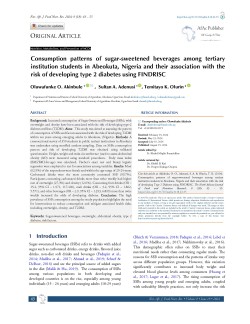Main Article Content
Consumption patterns of sugar-sweetened beverages among tertiary institution students in Abeokuta, Nigeria and their association with the risk of developing type 2 diabetes using FINDRISC
Abstract
Background: Increased consumption of Sugar-Sweetened Beverages (SSBs), with overweight and obesity have been associated with the risk of developing type-2 diabetes mellitus (T2DM).
Aims: This study was aimed at assessing the pattern of consumption of SSBs and factors associated with the risk of developing T2DM within ten years among emerging adults in Abeokuta, (Nigeria).
Methods: A cross-sectional survey of 350 students in public tertiary institutions in Abeokuta was undertaken using stratified random sampling. Data on SSBs consumption pattern and risk of developing T2DM was obtained using validated questionnaire. Height, weight and waist circumference (used to assess abdominal obesity (AO) were measured using standard procedures. Body mass index (BMI/BMI-for-age) was calculated. Fischer’s exact test and binary logistic regression were employed to test for associations among variables.
Results: Most (62.9%) of the respondents were female and within the age-range of 20-24 years. Carbonated drinks were the most commonly consumed SSB (99.7%). Participants consuming carbonated drinks more than twice weekly had higher rate of overweight (27.3%) and obesity (12.0%). Consuming fruit drinks (OR = 15.2, 95% CI = 1.971, 117.400), malt drinks (OR = 3.2, 95% CI = 1.862, 5.571), and other beverages (OR = 2.9, 95% CI = 1.293, 6.899) more than twice weekly increased the odds of developing diabetes.
Conclusion: The high prevalence of SSB consumption among the study population highlights the need for interventions to reduce consumption and mitigate associated health risks, including overweight, obesity, and T2DM.







